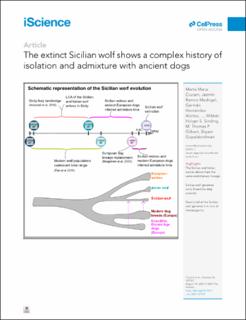| dc.contributor.author | Ciucani, Marta Maria | |
| dc.contributor.author | Ramos-Madrigal, Jazmín | |
| dc.contributor.author | Hernández-Alonso, Germán | |
| dc.contributor.author | Carmagnini, Alberto | |
| dc.contributor.author | Aninta, Sabhrina Gita | |
| dc.contributor.author | Sun, Xin | |
| dc.contributor.author | Scharff-Olsen, Camilla Hjorth | |
| dc.contributor.author | Lanigan, Liam Thomas | |
| dc.contributor.author | Fracasso, Ilaria | |
| dc.contributor.author | Clausen, Cecilie G. | |
| dc.contributor.author | Aspi, Jouni | |
| dc.contributor.author | Kojola, Ilpo | |
| dc.contributor.author | Baltrūnaitė, Laima | |
| dc.contributor.author | Balčiauskas, Linas | |
| dc.contributor.author | Moore, Jane | |
| dc.contributor.author | Åkesson, Mikael | |
| dc.contributor.author | Saarma, Urmas | |
| dc.contributor.author | Hindrikson, Maris | |
| dc.contributor.author | Hulva, Pavel | |
| dc.contributor.author | Bolfíková, Barbora Černá | |
| dc.contributor.author | Nowak, Carsten | |
| dc.contributor.author | Godinho, Raquel | |
| dc.contributor.author | Smith, Steve | |
| dc.contributor.author | Paule, Ladislav | |
| dc.contributor.author | Nowak, Sabina | |
| dc.contributor.author | Mysłajek, Robert W. | |
| dc.contributor.author | Lo Brutto, Sabrina | |
| dc.contributor.author | Ciucci, Paolo | |
| dc.contributor.author | Boitani, Luigi | |
| dc.contributor.author | Vernesi, Cristiano | |
| dc.contributor.author | Stenøien, Hans Kristen | |
| dc.contributor.author | Smith, Oliver | |
| dc.contributor.author | Frantz, Laurent | |
| dc.contributor.author | Rossi, Lorenzo | |
| dc.contributor.author | Angelici, Francesco Maria | |
| dc.contributor.author | Cilli, Elisabetta | |
| dc.contributor.author | Sinding, Mikkel Holger Strander | |
| dc.contributor.author | Gilbert, Marcus Thomas Pius | |
| dc.contributor.author | Gopalakrishnan, Shyam | |
| dc.date.accessioned | 2023-11-06T08:57:17Z | |
| dc.date.available | 2023-11-06T08:57:17Z | |
| dc.date.created | 2023-08-30T11:22:12Z | |
| dc.date.issued | 2023 | |
| dc.identifier.citation | iScience. 2023, 26 (8), . | en_US |
| dc.identifier.issn | 2589-0042 | |
| dc.identifier.uri | https://hdl.handle.net/11250/3100703 | |
| dc.description.abstract | The Sicilian wolf remained isolated in Sicily from the end of the Pleistocene until its extermination in the 1930s–1960s. Given its long-term isolation on the island and distinctive morphology, the genetic origin of the Sicilian wolf remains debated. We sequenced four nuclear genomes and five mitogenomes from the seven existing museum specimens to investigate the Sicilian wolf ancestry, relationships with extant and extinct wolves and dogs, and diversity. Our results show that the Sicilian wolf is most closely related to the Italian wolf but carries ancestry from a lineage related to European Eneolithic and Bronze Age dogs. The average nucleotide diversity of the Sicilian wolf was half of the Italian wolf, with 37–50% of its genome contained in runs of homozygosity. Overall, we show that, by the time it went extinct, the Sicilian wolf had high inbreeding and low-genetic diversity, consistent with a population in an insular environment. | en_US |
| dc.language.iso | eng | en_US |
| dc.publisher | Elsevier | en_US |
| dc.rights | Attribution-NonCommercial-NoDerivatives 4.0 Internasjonal | * |
| dc.rights.uri | http://creativecommons.org/licenses/by-nc-nd/4.0/deed.no | * |
| dc.title | The extinct Sicilian wolf shows a complex history of isolation and admixture with ancient dogs | en_US |
| dc.title.alternative | The extinct Sicilian wolf shows a complex history of isolation and admixture with ancient dogs | en_US |
| dc.type | Peer reviewed | en_US |
| dc.type | Journal article | en_US |
| dc.description.version | publishedVersion | en_US |
| dc.source.pagenumber | 0 | en_US |
| dc.source.volume | 26 | en_US |
| dc.source.journal | iScience | en_US |
| dc.source.issue | 8 | en_US |
| dc.identifier.doi | 10.1016/j.isci.2023.107307 | |
| dc.identifier.cristin | 2170857 | |
| cristin.ispublished | true | |
| cristin.fulltext | original | |
| cristin.qualitycode | 1 | |

